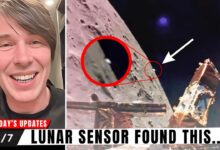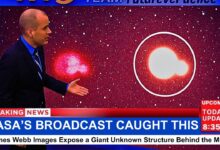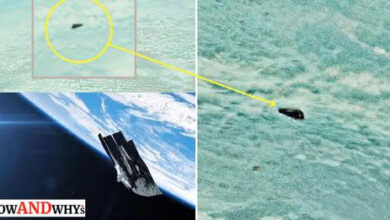What This Harvard Scientist Just Said About ʻOumuamua Changes Everything
Was Umuamua a Silent Alien Probe? Harvard Scientist Reignites Debate on First Contact
In October 2017, a mysterious object hurtled through our solar system—and vanished just as quickly. Named ‘Oumuamua (meaning “scout” or “messenger” in Hawaiian), it was the first known interstellar object ever observed passing through our cosmic neighborhood. But what if this wasn’t just a space rock? What if it was something more—something watching us?
That’s exactly the possibility Harvard astrophysicist Professor Avi Loeb has reignited, challenging the mainstream narrative and suggesting a radical alternative: Oumuamua wasn’t natural at all—it was a probe.
A Visitor Unlike Any Other
Unlike anything we’d ever seen, Oumuamua baffled scientists. It had no tail like a comet, no visible gas or dust emissions, and its shape was extremely elongated—cigar-like or possibly pancake-flat. Even more puzzling was its behavior: as it exited the solar system, it accelerated in a way that couldn’t be explained by gravity alone.
The leading theory suggested that trapped hydrogen gas caused this unexplained acceleration. But in 2023, Loeb and physicist Thiem Hoang published a damning rebuttal. Their analysis revealed that hydrogen would cool the object’s surface too rapidly, preventing the necessary outgassing. In short, the math didn’t work. This undercut the most accepted natural explanation—and reopened the door to something extraordinary.
Silent SETI: Are We Being Watched?
Loeb has long proposed a theory he calls “Silent SETI”—searching for artifacts instead of alien messages. Instead of listening for radio waves from distant civilizations, what if we looked for physical objects that might have been sent to observe us?
In 2023, Loeb took this idea further. He co-authored a paper with Dr. Sean Kirkpatrick, head of the Pentagon’s All-Domain Anomaly Resolution Office (AARO). They proposed that advanced civilizations could send motherships into interstellar space, which would then deploy smaller probes to scan habitable planets—exactly like Earth.
Oumuamua, they argue, could have been one of these smaller probes.
A Technological Footprint?
Loeb’s most elegant and compelling theory? Oumuamua might have been a light sail—a thin, reflective structure powered by starlight. This would explain the object’s unexplained acceleration, high reflectivity, and unusual shape. His calculations show that if the object were less than a millimeter thick, sunlight alone could have propelled it—no engines, no fuel, no emissions.
This concept isn’t science fiction. Loeb co-founded Breakthrough Starshot, a real project to build and launch such sails toward nearby star systems. Funded with $100 million and backed by physicist Stephen Hawking and billionaire Yuri Milner, this effort proves the idea is scientifically and technologically credible.
What If We Were Scanned?
If Oumuamua was indeed an interstellar probe, it may have quietly collected data as it passed through the habitable zone of our solar system. It could have scanned Earth’s magnetic field, radio signals, or atmosphere, transmitting this data back to its origin without us ever noticing.
More unsettling is the possibility that it was just one of many. If this probe slipped by undetected until 2017—thanks only to a lucky alignment with our telescopes—how many others might have passed unnoticed?
Alien Origins? Clues in the Atoms
Some Harvard-affiliated scientists now propose that objects like Oumuamua may carry unique chemical signatures—like isotopic “barcodes” from their home systems. Every star has a distinct chemical fingerprint, and anything formed around it would carry a telltale blend of elements and isotopes.
If we ever manage to analyze one of these objects directly and discover metal ratios or isotopes unknown to our solar system, it could be the smoking gun—proof that the object was artificial, not natural. As Loeb puts it: “If we found a cell phone on Mars, we wouldn’t assume it formed naturally.”
We Missed Our Chance—But Not the Next One
We may never know the true nature of Oumuamua. It’s now speeding away at 57,000 mph—far beyond our reach. But we may soon get a second chance.
New telescopes like the Vera Rubin Observatory will begin operations soon, capable of detecting 10+ interstellar objects per year. NASA and the European Space Agency (ESA) are already planning rapid-launch interceptor missions that could fly out and study the next visitor up close—perhaps even capture or sample it.
Had Oumuamua appeared just five years later, we could have intercepted it.
Implications Beyond Science
If Loeb is right—and if Oumuamua was a probe—this would be the most profound discovery in human history. It would mean we are not alone. Someone out there is not only technologically advanced but interested in us.
The implications would ripple across every domain—from theology and philosophy to security, technology, and international cooperation. Governments would invest heavily in space surveillance and exploration. Humanity’s place in the cosmos would shift overnight—from center stage to just one act in a much larger play.
Are We Already Part of a Galactic Census?
One final, haunting thought: what if Oumuamua was just a scout? What if it came to evaluate Earth’s technological maturity and report back? Some scientists have even speculated that it may have been part of a panspermia mission—delivering life across the stars.
Whatever its mission, Oumuamua reminded us of something profound: we weren’t ready. But now we are.
With new observatories, fast-response interceptors, and a growing willingness to consider the unthinkable, the next visitor won’t get away unnoticed. The next time the stars send us a messenger—we’ll be listening.
And perhaps… watching back.




